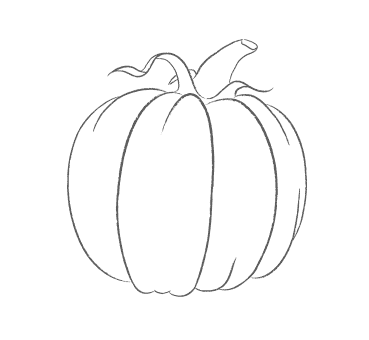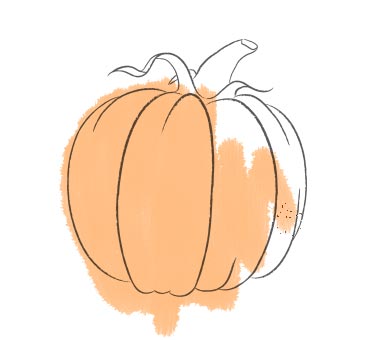In Australian English, the name 'pumpkin' generally refers to the broader category called winter squash in North America.
Since some squash share the same botanical classifications as pumpkins, the names are frequently used interchangeably. In general, pumpkin stems are more rigid, prickly, and angular (with an approximate five-degree angle) than squash stems, which are generally softer, more rounded, and more flared where joined to the fruit.
Pumpkins generally weigh 9–18 lbs (4–8 kg) with the largest (of the species C. maxima) capable of reaching a weight of over 75 lbs (34 kg). The pumpkin varies greatly in shape, ranging from oblate to oblong. The rind is smooth and usually lightly ribbed. Although pumpkins are usually orange or yellow, some fruits are dark green, pale green, orange-yellow, white, red and gray.
Pumpkins are monoecious, having both male and female flowers on the same plant. The female flower is distinguished by the small ovary at the base of the petals. These bright and colorful flowers have extremely short life spans and may only open for as short a time as one day. The color of pumpkins is derived from the orange pigments abundant in them. The main nutrients are lutein and both alpha and beta carotene, the latter of which generates vitamin A in the body.
Pumpkin is the fruit of the species Cucurbita pepo or Cucurbita mixta. It can refer to a specific variety of the species Cucurbita maxima or Cucurbita moschata, which are all of the genus Cucurbita and the family Cucurbitaceae.
Pumpkins are grown all around the world for a variety of reasons ranging from agricultural purposes (such as animal feed) to commercial and ornamental sales. Of the seven continents, only Antarctica is unable to produce pumpkins; the biggest international producers of pumpkins include the United States, Mexico, India, and China. The traditional American pumpkin is the Connecticut Field variety.
As one of the most popular crops in the United States, 1.5 billion pounds (680,000,000 kilograms) of pumpkins are produced each year. The top pumpkin-producing states in the U.S. include Illinois, Indiana, Ohio, Pennsylvania, and California. According to the Illinois Department of Agriculture, 95% of the U.S. crop intended for processing is grown in Illinois. Nestlé produces 85% of the processed pumpkin in the U.S. In the fall of 2009, rain in Illinois devastated the Nestlé crop, resulting in a shortage affecting the entire country during the Thanksgiving holiday season. Pumpkins are a warm-weather crop that is usually planted in early July. The specific conditions necessary for growing pumpkins require that soil temperatures three inches (7.62 cm) deep are at least 60 °F (15.5 °C) and soil that holds water well. Pumpkin crops may suffer if there is a lack of water or because of cold temperatures (in this case, below 65 °F (18.3 °C); frost can be detrimental), and sandy soil with poor water retention or poorly drained soils that become waterlogged after heavy rain. Pumpkins are, however, rather hardy, and even if many leaves and portions of the vine are removed or damaged, the plant can very quickly re-grow secondary vines to replace what was removed. Pumpkins produce both a male and female flower; honeybees play a significant role in fertilization. Pumpkins have historically been pollinated by the native squash bee Peponapis pruinosa, but this bee has declined, probably due to pesticide sensitivity,[citation needed] and today most commercial plantings are pollinated by honeybees. One hive per acre (4,000 m² per hive) is recommended by the United States of America (US) Department of Agriculture. If there are inadequate bees for pollination, gardeners often have to hand pollinate. Inadequately pollinated pumpkins usually start growing but abort before full development. An opportunistic fungus is also sometimes blamed for abortions.[citation needed]
Since some squash share the same botanical classifications as pumpkins, the names are frequently used interchangeably. In general, pumpkin stems are more rigid, prickly, and angular (with an approximate five-degree angle) than squash stems, which are generally softer, more rounded, and more flared where joined to the fruit.
Pumpkins generally weigh 9–18 lbs (4–8 kg) with the largest (of the species C. maxima) capable of reaching a weight of over 75 lbs (34 kg). The pumpkin varies greatly in shape, ranging from oblate to oblong. The rind is smooth and usually lightly ribbed. Although pumpkins are usually orange or yellow, some fruits are dark green, pale green, orange-yellow, white, red and gray.
 halloween coloring pictures |  Here are some halloween |  Label: Halloween coloring pics |  Step 2 - The basic colour |  Free Halloween Scarecrow |
 Halloween Pumpkin Colouring |  Happy Halloween Card to Color |  Halloween Greeting Card |  made up a colour by number |  Halloween |
Pumpkins are grown all around the world for a variety of reasons ranging from agricultural purposes (such as animal feed) to commercial and ornamental sales. Of the seven continents, only Antarctica is unable to produce pumpkins; the biggest international producers of pumpkins include the United States, Mexico, India, and China. The traditional American pumpkin is the Connecticut Field variety.
 Halloween |  HALLOWEEN DISNEY IMAGES TO |  More fun Halloween coloring |  But maybe I\x26#39;ll colour it |  Halloween masks to colour in - |
 Now that\x26#39;s your basic colour |  Halloween Colourings |  Bats |  Colour in this $man at | Why not colour in this picture |
No comments:
Post a Comment